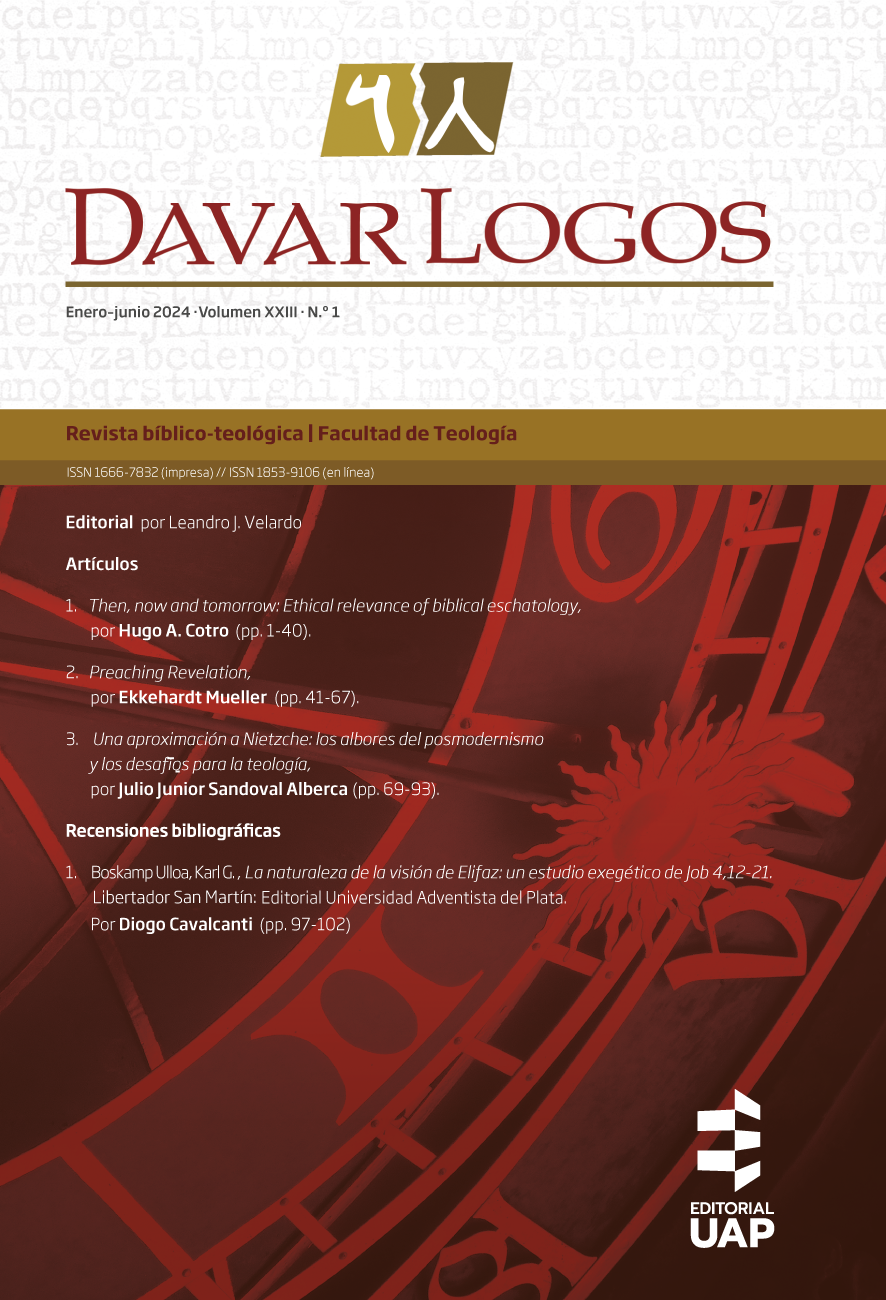Preaching Revelation
DOI:
https://doi.org/10.56487/dl.v23i1.1143Keywords:
Hermeneutics – Exegesis – New Testament – Revelation – PreachingAbstract
There is much scholarly and non-scholarly interest in the Book of Revelation. This article
argues that the book must be preached, but this must be done after serious study to avoid
superficiality and speculative interpretation. Even as a sermon on Revelation will apply
the text to the current audiences’ situations, it must be true to the message of the Apocalypse. In this article we will (a) address some basics on preaching, (b) suggest why it is important to preach Revelation, (c)and mention prerequisites for and pitfalls of preaching
Revelation. Furthermore, the article contains a proposal of what to preach, providing
lists of passages and topics that may be of interest to the preacher. It also offers some
examples of outlines for preaching. The article will not be dealing with rhetoric and the
delivery of a sermon, but its focus is on content.
Downloads
References
Here is a ten step suggestion of how to do exegesis. This is a summary only. There is much more to be said and done than what appears here:
Step 1. Take time. Studying Scripture requires time.
Step 2. Turn to God in prayer for help to understand His Word.
Step 3. Read the text and also its context repeatedly.
Step 4. Establish the best possible reading. This is a step for biblical scholars only.
Step 5. Translate the text if you are a scholar. Otherwise check good translations.
Sept 6. Investigate the historical context and especially the literary context.
Step 7. Analyze the text/passage under consideration.
Step 8. Perform theological analysis, that is, look for themes.
Step 9. Apply the text to us today.
Step 10. Use resources mainly after having studied the text/passage. For more information, see Richard M. Davidson, “Biblical interpretation,” in Handbook of Seventh- day Adventist theology, ed. by Raoul Dederen (Hagerstown, MD: Review and Herald Publishing Association, 2000), 58-104, Ekkehardt Mueller, “Guidelines for the interpretation of Scripture,” in Understanding Scripture: An Adventist approach, Biblical Research Institute Studies, vol. 1, ed. by G. W. Reid (Silver Spring, MD: Biblical Research Institute, 2006), 111-134; Mueller, “Principles of biblical interpretation,” unpublished paper, 2019.
The historical context consists of the political, cultural, religious, and social situation when a biblical book was written and to which the text was addressed. The literary context consists of the passages preceding and following a text (immediate context), a biblical book, other biblical books (larger context) and the entire Bible (largest context). Biblical texts oftentimes relate to other texts (Old Testament and/or New Testament) and may reveal important themes of the Bible. The literary context determines to a large extent the meaning of words and the message of the passage. The study of the context may consist of providing a structure of the context. It has also to do with the delimitation of biblical passages. This is especially important in apocalyptic prophecy where the beginning and the end of a passage may be crucial to its interpretation. The study of the context may also take in consideration different literary genres (e.g., legal texts, wisdom literature, classical prophecy, apocalyptic literature, letters). Although the general principles of interpretation apply more or less to all genres, there are differences that need to be taken into account.
Analyzing a biblical text or passage includes the investigation of the structure of the text, its literary genre and form, and its larger units, sentences, phrases, and individuals words. Consequently, grammar and syntax must be studied. Words and phrases need to be traced through the entire biblical book in which the text/passage is found and sometimes even through the rest of Scripture. However, one needs to keep in mind that words may have different meanings in different contexts, may change over time, and that root meanings are not always useful. Still the tracing of words and phrases may help to determine the main message of the passage and its interconnectedness to other parts of Scripture. Biblical terms must be understood literally unless verse or immediate context indicate a figurative meaning. Furthermore, words must be defined
by the biblical context, not by modern usage. Literary and rhetorical features should be observed such as rhetorical questions, irony, sarcasm, and comparisons. Questions have to be asked: What is the time frame of the passage? What is its geographical location? Who are the important figures and how do they act and speak? What is the main message? An allegorical approach must be avoided. However, biblical typology should be recognized.
The application must be based on the preceding steps and should not go wild. Here the type of literature has to come into consideration. Some texts are of a permanent nature (e.g., those based on moral law and wisdom passages) while other are not (e.g., those dealing with theocratic laws). In the first case, the application can be direct. In the second case, it has to be based on a
permanent principle derived from the passage under consideration. In a sermon, it is normally better to focus on the most important aspect of the text/passage rather than confuse the audience with many different applications. One aspect of application has been called personalization. Because humans share so much with each other, the text can be personalized on an individual level and on a group level. What does God/Jesus want to tell me with this passage? How does it affect my commitment to Him, my insights into His character and His plan for us, my actions, and my obedience? How can I respond to His message? How does the respective biblical text affect us as a church? In which areas of our church life does Jesus challenge us? How does the text educate and teach us? How does God use the biblical passage to comfort and encourage us? Our response to these questions can, for instance, be praise and thanksgiving, petitions and intercession, and/or changing our lives and our value system.
For an example, not of a sermon but of a church statement that is based on biblical principles, see Seventh-day Adventist Church, accessed 11/4/2019, https://gc.adventist.org/official-statements/statement-on-the-biblical-view-of-unborn-life-and-its-implications-for-abortion/.
See Ekkehardt Mueller, “Christological concepts in the Book of Revelation–Part 1: Jesus in the Apocalypse”, Journal of the Adventist Theological Society 22, nos 1-2 (2010): 276-305; Mueller, “Christological concepts in the Book of Revelation–Part 2: Christ’s divinity”, Journal of the Adventist Theological Society 21, no 1 (2011): 66-83; Mueller, “Christological concepts in the Book of Revelation–Part 3: The Lamb christology,” Journal of the Adventist Theological Society 21, no 2 (2011): 42-66.
See Ekkehardt Mueller, “O Espirito Santo no Apocalipse de Joao”, in Pneumatologia pessao e obra do Espirito Santo, ed. by Reinaldo W. Siqueira and Alberto Timm (Engenheiro Coelho, SP: Unaspress, 2017), 321-352.
This is “theology” in the narrow sense, the teaching of God.
Ellen G. White, The acts of the apostles (Mountain View, CA: Pacific Press, 1911), 583.
Ibid., 584.
Ellen G. White, Christ’s object lessons (Washington, DC: Review and Herald, 1900), 133.
Ellen G. White, Evangelism (Washington, D.C.: Review and Herald, 1946), 195-196.
This has been verified not only with our own preaching but also with students in a course on homiletics who prepare devotionals and present them publicly.
See Ekkehardt Mueller, “Challenges to the Adventist interpretation of Apocalyptic literature”, Journal of Asia Adventist Seminary 13, no 1 (2010): 49-70.
See, e.g., Connie Ordelheide-Anderson, Decoding the Bible prophecy of the 7 thunders (no place and no date), 150. Others use soft time setting, claiming that we are the last generation and that Jesus will definitely return in our life time or that the present pope is the last pope. Victor McGowan, The Revelation and the history of christendom: Prophecy fulfilled to the end of our time (N. p.: Universe, 2011), sets dates for the historical periods of the seven churches. Based on these dates he concludes: “If a time line is drawn for the church eras, it forms a symmetry of years that may suggest the time of the return of Christ” (McGowan, The Revelation and the history of christendom, 19). In a subsequent chart, he lists the year 2019 with a question mark.
When in 1986 the devastating nuclear accident happened in Chernobyl (then Soviet Union, today Ukraine) some people suggested that the name Chernobyl is related to wormwood and that this is a fulfillment of the third trumpet. See, e.g., One Year New Testament Blog, “Revelation 8: Does Chernobyl really mean wormwood? Well… yeah, kind of ”, accessed 11/5/2019, https://oneyearbibleblogentry.blogspot.com/2012/01/revelation-8-does-chernobyl-really-mean.html. McGowan, 40-51 suggests that the first of the seven plagues stands for syphilis, the second for Muslims controlling the Mediterranean Sea, the third for the Thirty Years War, the fourth the period from sun king Louis XIV to Napoleon, the fifth for papal darkness, the sixth for the three frogs of Nietzsche, Marx, and Darwin, and the seventh for World War II.
See Erwin R. Gane, Trumpet after trumpet: Will Revelation’s seven trumpets sound again? (Nampa, ID: Pacific Press Publishing Association, 2012). After the publication of this book, Pacific Press Publishing Association refused to publish his full commentary on Revelation due to the approach that he took.
This is a problem with the King James Version. The term “meat” then designated food, and “gay” meant “happy” and “lively”.
See the three types or categories of sermons above.
Scott Gambrill Sinclair, Revelation: A book for the rest of us (Berkeley, CA: Bibal Press, 1992), 155-156.
If verse 8 is added, it should be noted that this verse speaks about God the Father (see verse 3), not about Jesus.
Revelation 4 is probably the most important throne vision of Revelation. Revelation 3,21 prepares for it. Revelation depicts the enthronement of Jesus as Priest-King after His ascension.
Although the two scenes are similar, they are not identical. Revelation 7b may play in heaven probably during the Millennium, while Revelation 21,3-4 play on the new earth.
See the similarity but the different tenses for the term “to wash”.
See Ekkehardt Mueller, “The two witnesses of Revelation 11”. Journal of the Adventist Theological Society 13, no 2 (2002): 30-45. Notice verse 8, the only text in Revelation that mentions directly Jesus’ crucifixion.
Revelation 3,20 uses the cognate verb of “supper” in Revelation 19,9.
See footnote 15.
See footnote 16.
E.g., Philip L Mayo, “Those who call themselves Jews: The Church and Judaism in the Apocalypse of John”, Princeton Theological Monograph Series (Eugene, OR: Pickwick, 2006); Olutola K. Peters, The mandate of the church in the Apocalypse, Studies in Biblical Literature 77 (New York: Peter Lang Publishing, 2005); Ekkehardt Mueller, “Introduction to the ecclesiology of Revelation”, in Pensar la iglesia hoy: hacia una eclesiología adventista, ed. by G. A. Klingbeil, M. G. Klingbeil, M. A. Nunez, 147-164 (Libertador San Martin, ER, Argentina: Editorial Universidad Adventista del Plata, 2002; Mueller, “The end time remnant in Revelation”, Journal of the Adventist Theological Society 11, nos 1-2 (2000): 188-204.
E.g., Ekkehardt Mueller, “Jesus and His Second Coming in the Apocalypse”, Journal of the Adventist Theological Society 11, nos 1-2 (2000): 205-215.
E.g., Ekkehardt Mueller, “Creation in the Book of Revelation”, unpublished paper 2019.
E.g., Ekkehardt Mueller, “Mission in the Book of Revelation,” in Message, mission, and unity of the church, Studies in Adventist Ecclesiology-2, ed. by Angel Manuel Rodriguez (Silver Spring, MD: Biblical Research Institute, 2013), 129-153.
One can address all the hymns in the book or the seven hymns in the seal vision or the five hymns in Revelation 4-5.
See, e.g., Labahn, Michael and Lehtipuu, Outi. Imagery in the Book of Revelation, Contributions to Biblical Exegesis and Theology (Leuven: Peters, 2011).
Sophie Laws, In the light of the Lamb: Imagery, parody, and theology in the Apocalypse of John, Good News Studies 31 (Wilmington, DE: Michael Glazier, 1988); Joe E. Lunceford, Parody and counterimaging in the Apocalypse (Eugene, OR: Wipf & Stock, 2009).
For this topic and others, see James L. Resseguie, Revelation unsealed: A narrative critical approach to John’s Apocalypse (Leiden, Paises Bajos: Brill, 1998).
E.g., Ekkehardt Mueller, “Babylon’s terminology in Revelation”, in The Word: Searching, living, teaching, vol. 1, Biblical Research Institute, ed. by Artur A. Stele, 131-145 (Silver Spring, MD: Biblical Research Institute, 2015); Mueller, “Revelation’s Babylon and its characteristics” in The Word: Searching, living, teaching, vol. 1. Biblical Research Institute, ed. by Artur A. Stele, 147-161 (Silver Spring, MD: Biblical Research Institute, 2015); Mueller, “Babylon identified” in The Word: Searching, living, teaching, vol. 1, Biblical Research Institute, ed. by Artur A Stele, 163-176 (Silver Spring, MD: Biblical Research Institute, 2015).
E.g., Rodney Lawrence Thomas, Magical motifs in the Book of Revelation, Library of New Testament Studies 416 (London: T & T Clark, 2009); Ekkehardt Mueller, “Evil powers and occult practices in the Apocalypse”, in The church, culture, and spirits: Adventism in Africa, ed. By Kwabena Donkor, 105-129 (Silver Spring, MD: Biblical Research Institute, 2011).
E.g., Ekkehardt Mueller, “Revelation’s perspective on persecution”, in The great controversy and the end of evil: Biblical and theological studies in honor of Ángel Manuel Rodríguez in celebration of His seventieth birthday, 251-262, ed. by Gerhard Pfandl (Silver Spring, MD: Biblical Research Institute, 2015).
Joel Vobel Musvosvi, Vengeance in the Apocalypse, Andrews University Seminary Doctoral Dissertation Series 17 (Berrien Springs, MI: Andrews University Press, 1993); Ekkehardt Mueller, “Justice is coming: Answers to basic questions about the Millennium”, Adventist World, August 2016, 22-23.
Russell, Preaching the Apocalypse, 208.
Ibid., 209-212.
Ekkehardt Mueller, “Reflections on worship in Revelation 4 and 5”, Reflections: The BRI Newsletter ( July 2012), 1-6.
Kelly, Revelation, 9.
Ibid. 12.
Downloads
Published
Issue
Section
License
Copyright (c) 2024 DavarLogos

This work is licensed under a Creative Commons Attribution-NonCommercial-ShareAlike 4.0 International License.




